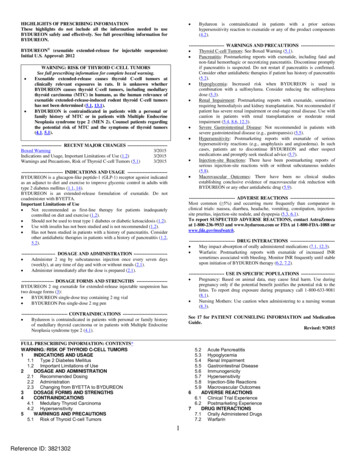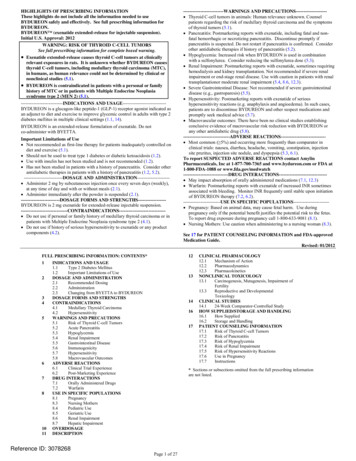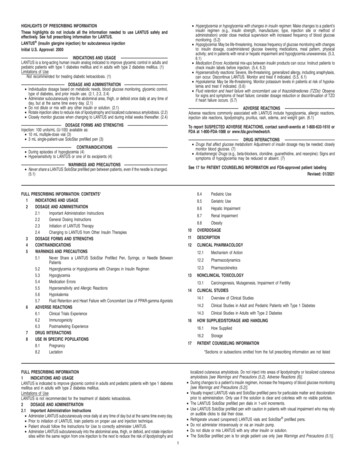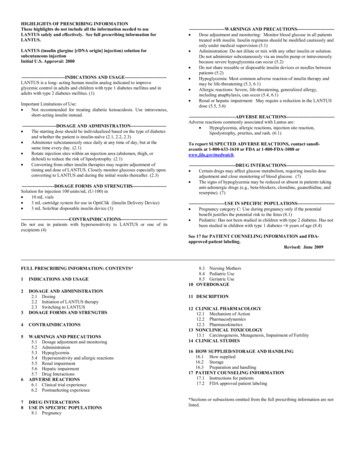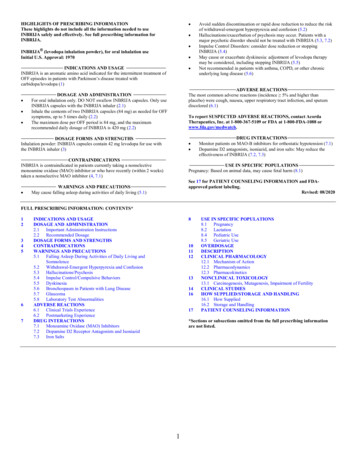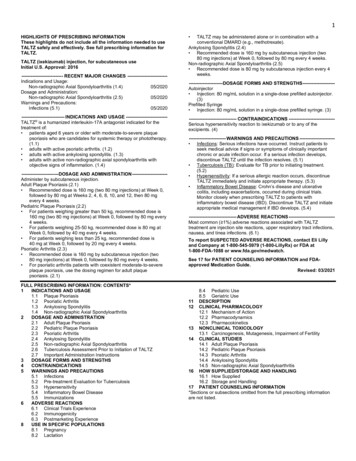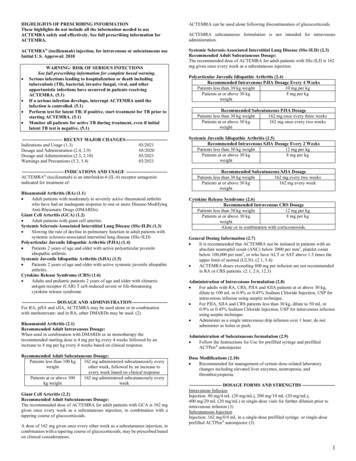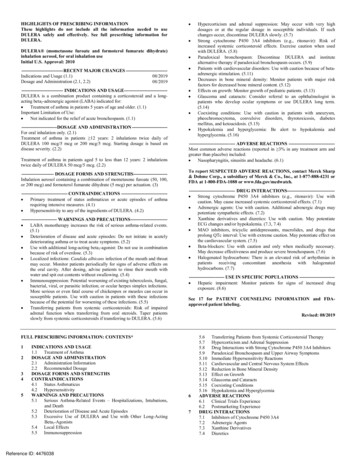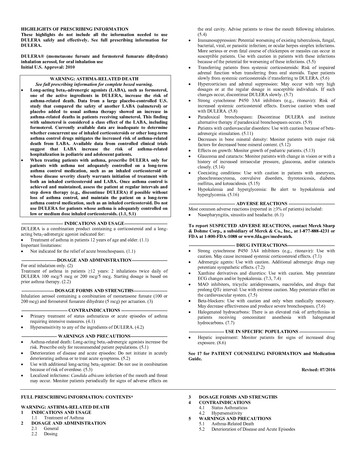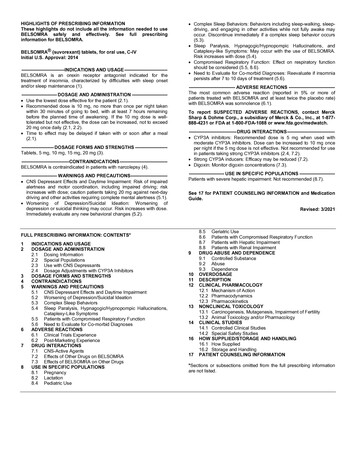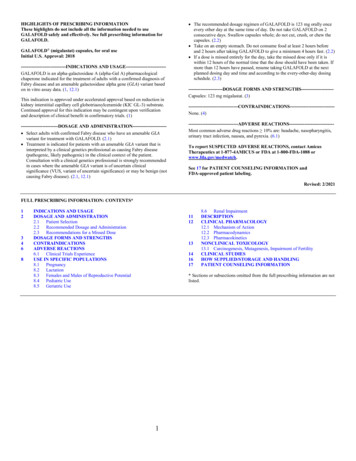
Transcription
HIGHLIGHTS OF PRESCRIBING INFORMATIONThese highlights do not include all the information needed to useGALAFOLD safely and effectively. See full prescribing information forGALAFOLD.GALAFOLD (migalastat) capsules, for oral useInitial U.S. Approval: 2018-----------------------------INDICATIONS AND USAGE-------------------------GALAFOLD is an alpha-galactosidase A (alpha-Gal A) pharmacologicalchaperone indicated for the treatment of adults with a confirmed diagnosis ofFabry disease and an amenable galactosidase alpha gene (GLA) variant basedon in vitro assay data. (1, 12.1)This indication is approved under accelerated approval based on reduction inkidney interstitial capillary cell globotriaosylceramide (KIC GL-3) substrate.Continued approval for this indication may be contingent upon verificationand description of clinical benefit in confirmatory trials. (1)------------------------DOSAGE AND ADMINISTRATION--------------------- Select adults with confirmed Fabry disease who have an amenable GLAvariant for treatment with GALAFOLD. (2.1) Treatment is indicated for patients with an amenable GLA variant that isinterpreted by a clinical genetics professional as causing Fabry disease(pathogenic, likely pathogenic) in the clinical context of the patient.Consultation with a clinical genetics professional is strongly recommendedin cases where the amenable GLA variant is of uncertain clinicalsignificance (VUS, variant of uncertain significance) or may be benign (notcausing Fabry disease). (2.1, 12.1) The recommended dosage regimen of GALAFOLD is 123 mg orally onceevery other day at the same time of day. Do not take GALAFOLD on 2consecutive days. Swallow capsules whole; do not cut, crush, or chew thecapsules. (2.2) Take on an empty stomach. Do not consume food at least 2 hours beforeand 2 hours after taking GALAFOLD to give a minimum 4 hours fast. (2.2) If a dose is missed entirely for the day, take the missed dose only if it iswithin 12 hours of the normal time that the dose should have been taken. Ifmore than 12 hours have passed, resume taking GALAFOLD at the nextplanned dosing day and time and according to the every-other-day dosingschedule. (2.3)----------------------DOSAGE FORMS AND STRENGTHS--------------------Capsules: 123 mg migalastat. NS----------------------------None. (4)--------------------------------ADVERSE REACTIONS----------------------------Most common adverse drug reactions 10% are: headache, nasopharyngitis,urinary tract infection, nausea, and pyrexia. (6.1)To report SUSPECTED ADVERSE REACTIONS, contact AmicusTherapeutics at 1-877-4AMICUS or FDA at 1-800-FDA-1088 orwww.fda.gov/medwatch.See 17 for PATIENT COUNSELING INFORMATION andFDA-approved patient labeling.Revised: 2/2021FULL PRESCRIBING INFORMATION: CONTENTS*123468INDICATIONS AND USAGEDOSAGE AND ADMINISTRATION2.1 Patient Selection2.2 Recommended Dosage and Administration2.3 Recommendations for a Missed DoseDOSAGE FORMS AND STRENGTHSCONTRAINDICATIONSADVERSE REACTIONS6.1 Clinical Trials ExperienceUSE IN SPECIFIC POPULATIONS8.1 Pregnancy8.2 Lactation8.3 Females and Males of Reproductive Potential8.4 Pediatric Use8.5 Geriatric Use1112131416178.6 Renal ImpairmentDESCRIPTIONCLINICAL PHARMACOLOGY12.1 Mechanism of Action12.2 Pharmacodynamics12.3 PharmacokineticsNONCLINICAL TOXICOLOGY13.1 Carcinogenesis, Mutagenesis, Impairment of FertilityCLINICAL STUDIESHOW SUPPLIED/STORAGE AND HANDLINGPATIENT COUNSELING INFORMATION* Sections or subsections omitted from the full prescribing information are notlisted.1
FULL PRESCRIBING INFORMATION1INDICATIONS AND USAGEGALAFOLD is indicated for the treatment of adults with a confirmed diagnosis of Fabry diseaseand an amenable galactosidase alpha gene (GLA) variant based on in vitro assay data [seeDosage and Administration (2.1) and Clinical Pharmacology (12.1)].This indication is approved under accelerated approval based on reduction in kidney interstitialcapillary cell globotriaosylceramide (KIC GL-3) substrate [see Clinical Studies (14)]. Continuedapproval for this indication may be contingent upon verification and description of clinicalbenefit in confirmatory trials.2 DOSAGE AND ADMINISTRATION2.1 Patient SelectionSelect adults with confirmed Fabry disease who have an amenable GLA variant for treatmentwith GALAFOLD [see Table 2 in Clinical Pharmacology (12.1)].Treatment is indicated for patients with an amenable GLA variant that is interpreted by a clinicalgenetics professional as causing Fabry disease (pathogenic, likely pathogenic) in the clinicalcontext of the patient. Consultation with a clinical genetics professional is stronglyrecommended in cases where the amenable GLA variant is of uncertain clinical significance(VUS, variant of uncertain significance) or may be benign (not causing Fabry disease).2.2 Recommended Dosage and AdministrationThe recommended dosage regimen of GALAFOLD is 123 mg orally once every other day at thesame time of day (do not take GALAFOLD on 2 consecutive days). Swallow capsules whole: donot cut, crush, or chew the capsules.Take GALAFOLD on an empty stomach. Do not consume food at least 2 hours before and2 hours after taking GALAFOLD to give a minimum 4 hours fast [see Clinical Pharmacology(12.3)]. Clear liquids can be consumed during this 4-hour period.2.3 Recommendations for a Missed DoseIf a dose is missed entirely for the day, take the missed dose of GALAFOLD only if it is within12 hours of the normal time that the dose should have been taken. If more than 12 hours havepassed, resume taking GALAFOLD at the next planned dosing day and time, according to theevery-other-day dosing schedule.3DOSAGE FORMS AND STRENGTHSCapsules: 123 mg of migalastat in a size “2” capsule with an opaque blue cap and opaque whitebody with “A1001” printed in black, containing white to pale brown powder.2
4CONTRAINDICATIONSNone.6ADVERSE REACTIONS6.1 Clinical Trials ExperienceBecause clinical trials are conducted under widely varying conditions, adverse reaction ratesobserved in the clinical trials of a drug cannot be directly compared to rates in the clinical trialsof another drug and may not reflect the rates observed in practice.In clinical trials, 139 patients with Fabry disease (79 females, 60 males, 92% Caucasian, ages16 to 72 years), who were naïve to GALAFOLD or previously treated with enzyme replacementtherapy, were exposed to at least one dose of GALAFOLD. Of the 139 patients, 127 patientswere exposed to GALAFOLD 123 mg every other day for 6 months and 123 patients wereexposed for greater than one year. The clinical trials included one randomized, double-blind,placebo-controlled clinical trial of 6 months duration followed by a 6-month open-labeltreatment phase (Study 1) [see Clinical Studies (14)]. A second trial was a randomized,open-label, active-controlled clinical trial of 18 months duration in patients with Fabry diseasereceiving enzyme replacement therapy who were randomized to either switch to GALAFOLD orcontinue enzyme replacement therapy (Study 2; NCT01218659). In addition, there were twoopen-label, long-term extension trials.The most common adverse reactions reported with GALAFOLD ( 10%) during the 6-monthplacebo-controlled, double-blind phase of Study 1 were headache, nasopharyngitis, urinary tractinfection, nausea, and pyrexia.Table 1 shows adverse reactions reported in at least 5% of patients treated with GALAFOLD(and at a higher rate than placebo) during the 6-month placebo-controlled, double-blind phase ofStudy 1.3
Table 1:Adverse Reactions* Reported During the First 6 Months of Treatment inPatients with Fabry Disease in Study 1Adverse ReactionGALAFOLD%(N 34)Placebo%(N 33)Headache35%21%Nasopharyngitis18%6%Urinary tract infection**15%0Nausea12%6%Pyrexia12%3%Abdominal pain9%3%Back pain9%0Cough9%0Diarrhea9%3%Epistaxis9%3%* reported in at least 5% of patients treated with GALAFOLD and at a higher rate than placebo** included urinary tract infection, cystitis, and kidney infectionAdverse reactions reported in 5% of patients who received GALAFOLD in the 6-monthopen-label treatment phase of Study 1, in Study 2, and in the long-term extension trials (N 115,mean duration of treatment 2.7 years) included those reported in Table 1 with the addition ofvomiting.8USE IN SPECIFIC POPULATIONS8.1 PregnancyPregnancy Exposure StudyThere is a study that collects data on pregnant women with Fabry disease, either exposed orunexposed to GALAFOLD. Healthcare providers are encouraged to register patients or obtainadditional information by contacting the Pregnancy Coordinating Center at 1-888-239-0758,email fabrypregnancy@ubc.com, or visit www.fabrypregnancyregistry.com.Risk SummaryThere were three pregnant women with Fabry disease exposed to GALAFOLD in clinical trials.As such, the available data are not sufficient to assess drug associated risks of major birthdefects, miscarriage, or adverse maternal or fetal outcomes. In animal reproduction studies, noadverse developmental effects were observed (see Data).The estimated background risk for major birth defects and miscarriage for the indicatedpopulation is unknown. All pregnancies have a background risk of birth defect, loss, or other4
adverse outcomes. In the U.S. general population, the background risk of major birth defects andmiscarriage in clinically recognized pregnancies is 2% to 4% and 15% to 20%, respectively.DataAnimal DataNo adverse developmental effects were observed with oral administration of migalastat topregnant rats and rabbits during organogenesis at doses up to 26 and 54 times, respectively, therecommended dose based on AUC. No effects on post-natal development were observedfollowing oral administration of up to 500 mg/kg migalastat twice daily to pregnant rats(16 times the recommended dose based on AUC) during organogenesis and through lactation.8.2 LactationRisk SummaryThere are no human data available on the presence of migalastat in human milk, the effects onthe breastfed infant, or the effects on milk production. Migalastat is present in the milk oflactating rats (see Data). When a drug is present in animal milk, it is likely that the drug will bepresent in human milk. The developmental and health benefits of breastfeeding should beconsidered along with the mother’s clinical need for GALAFOLD and any potential adverseeffects on the breastfed child from GALAFOLD or from the underlying maternal condition.There is a study that collects data on effects of GALAFOLD on lactation for women with Fabrydisease and their neonates and infants up to 1 year of age who are exposed through breast milk.Healthcare providers are encouraged to register patients or obtain additional information bycontacting the Pregnancy Coordinating Center at 1-888-239-0758, emailfabrypregnancy@ubc.com, or visit www.fabrypregnancyregistry.com.DataAnimal DataMigalastat concentrations in milk from rats following oral administration of up to 500 mg/kgtwice daily (approximately 16 times the recommended human dose based on AUC) wasapproximately 2.5 times higher than levels in the rat maternal plasma at 4 hours post-dose. Theconcentration of migalastat in plasma from pups was approximately 11 times lower than thematernal plasma concentrations at 1-hour post-dose.8.3 Females and Males of Reproductive PotentialInfertilityThe effects of GALAFOLD on fertility in humans have not been studied. Transient and fullyreversible infertility in male rats was associated with migalastat treatment at a systemic exposure(AUC) equivalent to the human exposure at the recommended dose. Complete reversibility wasseen at 4 weeks after the termination of treatment. Migalastat did not affect fertility in femalerats [see Nonclinical Toxicology (13.1)].8.4 Pediatric UseThe safety and effectiveness of GALAFOLD have not been established in pediatric patients.5
8.5 Geriatric UseClinical trials of GALAFOLD did not include a sufficient number of patients 65 years and olderto determine whether they respond differently from younger patients.8.6 Renal ImpairmentMigalastat is substantially excreted by the kidneys. Systemic exposure was significantlyincreased in subjects with severe renal impairment (eGFR less than 30 mL/min/1.73 m2).GALAFOLD has not been studied in patients with Fabry disease who have an eGFR less than30 mL/min/1.73 m2. GALAFOLD is not recommended for use in patients with severe renalimpairment or end-stage renal disease requiring dialysis.No dosage adjustment is required in patients with mild to moderate renal impairment (eGFR atleast 30 mL/min/1.73 m2 and above) [see Clinical Pharmacology (12.3)].11 DESCRIPTIONMigalastat, an alpha-galactosidase A (alpha-Gal A) pharmacological chaperone, is a lowmolecular weight iminosugar and an analogue of the terminal galactose of globotriaosylceramide(GL-3).Migalastat is present in the form of a hydrochloride salt in GALAFOLD. The chemical name formigalastat hydrochloride is ( )-(2R,3S,4R,5S)-2-(hydroxymethyl) piperidine-3,4,5-triolhydrochloride. Its molecular formula is C6H13NO4 HCl, molecular mass is 199.63 g/mol, and itschemical structure is depicted below.Migalastat hydrochloride is a white to almost white crystalline solid. It is freely soluble inaqueous media within the pH range of 1.2 to 7.5.GALAFOLD (migalastat) capsules for oral administration contain 123 mg of migalastat(equivalent to 150 mg migalastat hydrochloride) as a white to pale brown powder and aresupplied in a size “2” hard gelatin capsule with an opaque blue cap and an opaque white bodyimprinted with “A1001” in black ink. The inactive ingredients are magnesium stearate andpregelatinized starch. Capsule shells consist of gelatin, indigotine - FD&C Blue 2, and titaniumdioxide. The black ink consists of black iron oxide, potassium hydroxide, and shellac.6
12CLINICAL PHARMACOLOGY12.1 Mechanism of ActionMigalastat is a pharmacological chaperone that reversibly binds to the active site of thealpha-galactosidase A (alpha-Gal A) protein (encoded by the galactosidase alpha gene, GLA),which is deficient in Fabry disease. This binding stabilizes alpha-Gal A allowing its traffickingfrom the endoplasmic reticulum into the lysosome where it exerts its action. In the lysosome, at alower pH and at a higher concentration of relevant substrates, migalastat dissociates fromalpha-Gal A allowing it to break down the glycosphingolipids globotriaosylceramide (GL-3) andglobotriaosylsphingosine (lyso-Gb3). Certain GLA variants (mutations) causing Fabry diseaseresult in the production of abnormally folded and less stable forms of the alpha-Gal A proteinwhich, however, retain enzymatic activity. Those GLA variants, referred to as amenable variants,produce alpha-Gal A proteins that may be stabilized by migalastat thereby restoring theirtrafficking to lysosomes and their intralysosomal activity.In Vitro Amenability AssayIn an in vitro assay (HEK-293 assay), Human Embryonic Kidney (HEK-293) cell lines weretransfected with specific GLA variants (mutations) which produced mutant alpha-Gal A proteins.In the transfected cells, amenability of the GLA variants was assessed after a 5-day incubationwith 10 micromol/L migalastat. A GLA variant was categorized as amenable if the resultantmutant alpha-Gal A activity (measured in the cell lysates) met two criteria: 1) it showed arelative increase of at least 20% compared to the pre-treatment alpha-Gal A activity, and 2) itshowed an absolute increase of at least 3% of the wild-type (normal) alpha-Gal A activity.The in vitro assay did not evaluate trafficking of the mutant alpha-Gal A proteins into thelysosome or the dissociation of migalastat from the mutant alpha-Gal A proteins within thelysosome. Also, the in vitro assay did not test whether a GLA variant causes Fabry disease or not.The GLA variants which are amenable to treatment with GALAFOLD, based on the in vitroassay data, are shown in Table 2. Inclusion of GLA variants in this table does not reflectinterpretation of their clinical significance in Fabry disease. Whether a certain amenable GLAvariant in a patient with Fabry disease is disease-causing or not should be determined by theprescribing physician (in consultation with a clinical genetics professional, if needed) prior totreatment initiation. Consultation with a clinical genetics professional is strongly recommendedin cases where the amenable GLA variant is of uncertain clinical significance (VUS, variant ofuncertain significance) or may be benign (not causing Fabry disease).Table 2:Amenable GLA Variants Based on the In Vitro AssayDNA Change (Long)DNA Change (Short)Protein Change(1-letter Code)Protein Change(3-letter Code)c.7C Gc.C7Gp.(L3V)p.(Leu3Val)c.8T Cc.T8Cp.(L3P)p.(Leu3Pro)c.[11G T; 620A 37G Ac.G37Ap.(A13T)p.(Ala13Thr)c.37G Cc.G37Cp.(A13P)p.(Ala13Pro)7
Table 2:Amenable GLA Variants Based on the In Vitro AssayDNA Change (Long)DNA Change (Short)Protein Change(1-letter Code)Protein Change(3-letter Code)c.43G Ac.G43Ap.(A15T)p.(Ala15Thr)c.44C Gc.C44Gp.(A15G)p.(Ala15Gly)c.53T Gc.T53Gp.(F18C)p.(Phe18Cys)c.58G Cc.G58Cp.(A20P)p.(Ala20Pro)c.59C Ac.C59Ap.(A20D)p.(Ala20Asp)c.65T Gc.T65Gp.(V22G)p.(Val22Gly)c.70T C or c.70T Ac.T70C or c.T70Ap.(W24R)p.(Trp24Arg)c.70T Gc.T70Gp.(W24G)p.(Trp24Gly)c.72G C or c.72G Tc.G72C or c.G72Tp.(W24C)p.(Trp24Cys)c.95T Cc.T95Cp.(L32P)p.(Leu32Pro)c.97G Tc.G97Tp.(D33Y)p.(Asp33Tyr)c.98A Gc.A98Gp.(D33G)p.(Asp33Gly)c.100A Cc.A100Cp.(N34H)p.(Asn34His)c.100A Gc.A100Gp.(N34D)p.(Asn34Asp)c.101A Cc.A101Cp.(N34T)p.(Asn34Thr)c.101A Gc.A101Gp.(N34S)p.(Asn34Ser)c.102T G or c.102T Ac.T102G or c.T102Ap.(N34K)p.(Asn34Lys)c.103G C or c.103G Ac.G103C or c.G103Ap.(G35R)p.(Gly35Arg)c.104G Ac.G104Ap.(G35E)p.(Gly35Glu)c.104G Tc.G104Tp.(G35V)p.(Gly35Val)c.107T Cc.T107Cp.(L36S)p.(Leu36Ser)c.107T Gc.T107Gp.(L36W)p.(Leu36Trp)c.108G C or c.108G Tc.G108C or c.G108Tp.(L36F)p.(Leu36Phe)c.109G Ac.G109Ap.(A37T)p.(Ala37Thr)c.110C Tc.C110Tp.(A37V)p.(Ala37Val)c.122C Tc.C122Tp.(T41I)p.(Thr41Ile)c.124A C or c.124A Tc.A124C or c.A124Tp.(M42L)p.(Met42Leu)c.124A Gc.A124Gp.(M42V)p.(Met42Val)c.125T Ac.T125Ap.(M42K)p.(Met42Lys)c.125T Cc.T125Cp.(M42T)p.(Met42Thr)c.125T Gc.T125Gp.(M42R)p.(Met42Arg)c.126G A or c.126G C orc.126G Tc.G126A or c.G126C orc.G126Tp.(M42I)p.(Met42Ile)c.137A Cc.A137Cp.(H46P)p.(His46Pro)8
Table 2:Amenable GLA Variants Based on the In Vitro AssayDNA Change (Long)DNA Change (Short)Protein Change(1-letter Code)Protein Change(3-letter Code)c.142G Cc.G142Cp.(E48Q)p.(Glu48Gln)c.152T Ac.T152Ap.(M51K)p.(Met51Lys)c.153G A or c.153G T orc.153G Cc.G153A or c.G153T orc.G153Cp.(M51I)p.(Met51Ile)c.[157A C; 158A T]c.A157C/A158Tp.(N53L)p.(Asn53Leu)c.157A Gc.A157Gp.(N53D)p.(Asn53Asp)c.160C Tc.C160Tp.(L54F)p.(Leu54Phe)c.161T Cc.T161Cp.(L54P)p.(Leu54Pro)c.164A Gc.A164Gp.(D55G)p.(Asp55Gly)c.164A Tc.A164Tp.(D55V)p.(Asp55Val)c.[164A T; 170A .167G Ac.G167Ap.(C56Y)p.(Cys56Tyr)c.167G Tc.G167Tp.(C56F)p.(Cys56Phe)c.170A Tc.A170Tp.(Q57L)p.(Gln57Leu)c.175G Ac.G175Ap.(E59K)p.(Glu59Lys)c.178C Ac.C178Ap.(P60T)p.(Pro60Thr)c.178C Tc.C178Tp.(P60S)p.(Pro60Ser)c.179C Tc.C179Tp.(P60L)p.(Pro60Leu)c.196G Ac.G196Ap.(E66K)p.(Glu66Lys)c.197A Gc.A197Gp.(E66G)p.(Glu66Gly)c.207C A or c.207C Gc.C207A or c.C207Gp.(F69L)p.(Phe69Leu)c.214A Gc.A214Gp.(M72V)p.(Met72Val)c.216G A or c.216G T orc.216G Cc.G216A or c.G216T orc.G216Cp.(M72I)p.(Met72Ile)c.218C Tc.C218Tp.(A73V)p.(Ala73Val)c.227T Cc.T227Cp.(M76T)p.(Met76Thr)c.239G Ac.G239Ap.(G80D)p.(Gly80Asp)c.239G Tc.G239Tp.(G80V)p.(Gly80Val)c.247G Ac.G247Ap.(D83N)p.(Asp83Asn)c.253G Ac.G253Ap.(G85S)p.(Gly85Ser)c.[253G A; 254G A]c.G253A/G254Ap.(G85N)p.(Gly85Asn)c.[253G A; 254G T; 255T G]c.G253A/G254T/T255Gp.(G85M)p.(Gly85Met)c.254G Ac.G254Ap.(G85D)p.(Gly85Asp)c.261G C or c.261G Tc.G261C or c.G261Tp.(E87D)p.(Glu87Asp)c.265C Tc.C265Tp.(L89F)p.(Leu89Phe)9
Table 2:Amenable GLA Variants Based on the In Vitro AssayDNA Change (Long)DNA Change (Short)Protein Change(1-letter Code)Prot
5 adverse outcomes. In the U.S. general population, the background risk of major birth defects and miscarriage in clinically recogni
